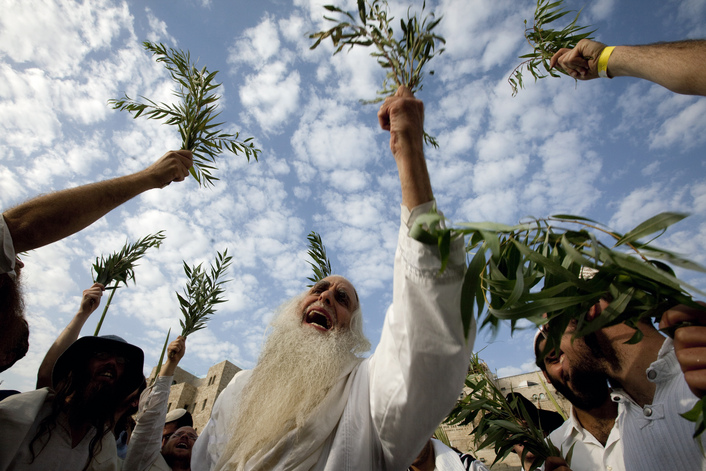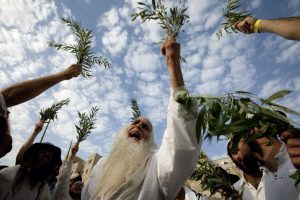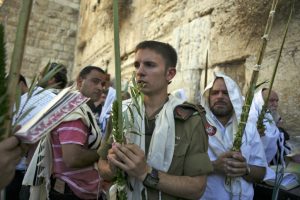Raboyseyee and Ladies:
Shoin, brace yourselves for another three day Yom Tov, six more meals and a few le’chaims. Ober how will the baseball fans know how just how the Yankees are faring while they’re in shul davening or perhaps even dancing a few short hakofos around the bima tomorrow night? Nu, the RBSO is mamish great: miraculously and efsher somewhat by design, kimat every shul has at least one member -usually more- who somehow know what’s going on. Inning by inning. And why is that? Nu, the RBSO mistama knew that absent of these givaldige messengers -holy people that they taka are- many might be inclined to leave their TV’s on over yom tov and chas v’sholom, might even be nicshoil and change the channel could they not rely on these holy messengers and bearers of sports flashes. Let’s go Yankees!
Nu, it’s taka erev Tom Tov and avada the Oisvorfer is busy making hachonis (preparations) for the big dances by loading up on bottles of Purell. Ober mamish minutes ago, he received an email, one of many this morning all asking di zelbe zach (same thing): where is the Bereishis edition? Asked one reader azoy: “Doesn’t the Ruv know that Yom Tov this year runs right into the heylige shabbis and that we, his forever loyal chasiddim, need shabbis tish material?” And wrote another about last year’s Bereishis edition: “………….. Was a classic. U should send it again.”
Avada the Ruv is humbled that the readers are mamish thirsty for more and here then is Bereishis for your reading pleasure. But first, a few thousand words on the upcoming three day Yom Tov food fest.
 Nu, we made it through the first six days of Sukkis and judging by the tightness of our hoizen (pants), the Yom Tov was quite filling. Maybe too much so. Because most of you have mamish no control when it comes to eating at a shul kiddish, followed shortly thereafter by another full meal at home, any resolutions you made about watching what you eat over Yom Tov are like other resolutions you made over Rosh Hashono about improved behavior: mistama by now also broken. Are we meant to look as round and bulbous as our esroigim by the time Yom Tov is over? Ver veyst?
Nu, we made it through the first six days of Sukkis and judging by the tightness of our hoizen (pants), the Yom Tov was quite filling. Maybe too much so. Because most of you have mamish no control when it comes to eating at a shul kiddish, followed shortly thereafter by another full meal at home, any resolutions you made about watching what you eat over Yom Tov are like other resolutions you made over Rosh Hashono about improved behavior: mistama by now also broken. Are we meant to look as round and bulbous as our esroigim by the time Yom Tov is over? Ver veyst?
The bottom line: orthodox Yiddin cannot maintain a diet because in the end, the allure and temptation of the shmorg at a kiddish is mamish too powerful. Perhaps stronger than the yetzer horo himself for other temptations, if you chap. While the Oisvorfer has seen many people walk away from business deals, and on rare occasions, even form the yetzer horo, he has yet to meet anyone that withstood the allure of the kiddish or shmorg! Shoin, gyms and personal trainers also need to make a parnoso (living).
By the time Yom Tov is over this coming Motzei shabbis, most of us will need spanx just to close our pants properly; the good news is that most of our wives, even the skinny ones, have a few pairs, oy vey! Why would a skinny woman own spanx, efsher you’re wondering? Shoin and poshit geredt (plain and simple): everyone chaps why larger women would want spanx ober the chiddish (breakthrough news) is that even skinny women have spanx. And taka why? Nu, it so happens that a good majority of skinny women don’t really believe they are skinny or skinny enough and therefore they too, collect and wear spanx from time to time. In the end, spanx are seemingly for everyone and especially so after a three day eating festival: ingenuous marketing, mamish.
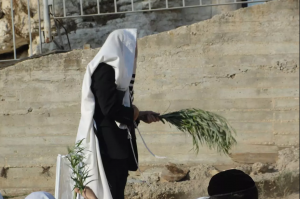 In any event, tomorrow, raboyseyee, is the special Yom Tov (holiday) of Hoishana Rabbah. What’s so special about a holiday that is not mentioned anywhere in the heylige Toirah by name or even by reference? Nu, believe it or not, our sages or maybe it dates back to our Nivi’im (Prophets) –we shall soon see- invented this day. Were they in the business of selling Arovos and had too much inventory left over on erev Sukkis, ver veyst? And taka selling bundles of 5 on clearance made some good economic sense. Is that what happened, ver veyst? One thing is zicher. There is no mention, none at all and that would include the heylige Toirah, the Mishna, the heylige Gemora and others sources that discuss this particular Holiday. Nu, how then did it come about?
In any event, tomorrow, raboyseyee, is the special Yom Tov (holiday) of Hoishana Rabbah. What’s so special about a holiday that is not mentioned anywhere in the heylige Toirah by name or even by reference? Nu, believe it or not, our sages or maybe it dates back to our Nivi’im (Prophets) –we shall soon see- invented this day. Were they in the business of selling Arovos and had too much inventory left over on erev Sukkis, ver veyst? And taka selling bundles of 5 on clearance made some good economic sense. Is that what happened, ver veyst? One thing is zicher. There is no mention, none at all and that would include the heylige Toirah, the Mishna, the heylige Gemora and others sources that discuss this particular Holiday. Nu, how then did it come about?
Moreover, while the great majority of mitzvois ah-say (positive commandments), be they Toirah or Rabbi mandated, do come with some form of explanation; no reason whatsoever is given for the minhag we have of beating the bundle of 5 hoishanis into the ground and zicher no explanation is found as to why we have the audacity to throw the beaten hoishanis on top of the Oron Koidesh that houses the heylige Toirahs. Who made this up?
Seemingly, this practice was invented by the prophets, some say, well over 2,000 years ago. Hoisha Na (lit: Please save) is, as we will learn below, mamish the day that Divine judgment for the year takes effect. And what reason did the Prophets give us for klapping (banging) Hoishanis on this day? They didn’t give us any! Shoin! Seemingly they either wanted to keep the reason hidden or efsher they thought that we would know intuitively why we find ourselves in a hoishanis beat-down, ver veyst.
Shoin, after exhaustive research the Oisvorfer found some explanation in the writing of Eliyahu Zuta who said azoy: the beating of the hoshanis causes the leaves to fall away and this act symbolizes “the falling away of the sparks of Divine Judgment. And on Hoishana Rabba, as we will address mamish below, we are attempting to cast away any negative judgment. How does all this work? And who said that hoshanis –willow branches– symbolize Divine Judgment? And how do we have the chutzpah to throw Divine judgment away? Nu, lommer lernin (let’s learn).
Seemingly, even back then, our sages realized how poorly behaved the Yiddin of their generations were and decided to take action. They chapped that although Yom Kippur was the date that the RBSO sealed the fate of all mankind, they decided that the Yiddin needed an extension. Shoin and just like that, they created Hoishana Rabba and told us that on this day and up until this day, despite Yom Kippur having passed more than 10 days earlier, we Yiddin can still somehow unseal the RBSO’s decree and have it re-written. We can? We can mamish unseal the RBSO’s decrees? How is that possible?
Nu, to chap this concept, we need to borrow a metaphor from our dentist friends and imagine that you are getting a crown installed or a replacement tooth, ver veyst. Initially the dentist will mistama install a crown with a sealant material ober will refer to the tooth and the sealant as temporary. Weeks later, he will install the permanent with everlasting sealant. Shoin, now you can chap. Seemingly the sages were able to convince the RBSO to only use temporary sealant materials on His Yom Kippur decrees and hold off on the final sealant until Hoishana Rabba. And therefore raboyseyeye, you have mamish until tomorrow to make final amends with the RBSO. You can still perform the Tashlich ceremony and try ridding yourself of your sins that way and of course you can bang away at the Hoishanis hoping that might work. Is any of this true, ver veyst? Or, are we efsher klapping Hoishanis tomorrow in vain or more likely for the plethora of avayrois you committed since Yom Kippur? The latter of course, the more likely scenario.
In any event, since its inception, Hoishana Rabba, technically the 7th day of Sukkis, has elements of a regular intermediate Sukkis day + sprinkles of Yom Kippur and the davening too is a combination of weekday, shabbis, Yom Tov. And to top it all off, it includes the hoishanis beating and when it’s all over, if you said at least half the words – no small challenge- you might have a shot, albeit a very long one, of having the RBSO soften up and change any negative decree coming your way, into something more manageable. And after klapping (beating and banging) your chests kimat (nearly) 500 times on Yoim Kippur, on this day, you get to bang one more time, if you chap. Can banging an innocent Hoishana (willow) save your life?
Ober listen to this. Says the heylige Zoihar (Tzav 31b) azoy: Hoishana Rabbah is a judgment day akin to Yom Kippur. For on Hoishana Rabbah the parchments containing the Yom Kippur decrees are made final. The Mystics state that whereas our fate was sealed on Yom Kippur, the writ containing the decision of the Court on High is only rubber-stamped – think permanent sealer-on the seventh day of Sukkis which is Hoishana Rabbah. Hence, until this day, a last-minute appeal to the Heavenly Supreme Court may carry some weight by virtue of extenuating circumstances. Those circumstances being that you put off repentance until the last minute, minuvil that you are.
And more good news: the good and decent people were previously judged on Rosh Hashanah. In fact, so were all others ober it appears, according to our wise rabbis, that those people not totally shlecht (evil), were extended until Yom Kippur to repent. If they failed to do so, the verdict against them was written and sealed, but not yet ‘delivered’. That will be done tomorrow and instead of chapping as you usually do, chap areyn some last minute tshuva; efsher you can still be saved, ver veyst.
And taka says the Medrish (sorry cannot find original source) that the RBSO said to Avrohom Ovenu azoy: “I will give your descendants a special day for forgiveness: If they are not forgiven on Rosh Hashona, then let them try repenting on Yom Kippur. If not, they will have until Hoishana Rabbah.”
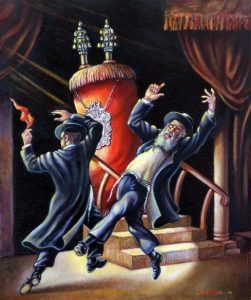 Avada you all know that on the first Shabbis following Simchas Toirah, the day we celebrated the completion of yet another Toirah reading cycle by making Kiddush often and by dancing and holding the sweaty hands of other grown men in Shul we barely say hello to during the year, we begin all over again. Welcome to Parshas Bereishis, and this Shabbis we’ll read how the RBSO crated di gantze velt (the entire world) in six days and rested on the seventh; shoin, the heylige shabbis was born, and ever since, thousands of pages have been and continue to be written about its observance. Nu, let’s not spend time on this subject, it’s never-ending.
Avada you all know that on the first Shabbis following Simchas Toirah, the day we celebrated the completion of yet another Toirah reading cycle by making Kiddush often and by dancing and holding the sweaty hands of other grown men in Shul we barely say hello to during the year, we begin all over again. Welcome to Parshas Bereishis, and this Shabbis we’ll read how the RBSO crated di gantze velt (the entire world) in six days and rested on the seventh; shoin, the heylige shabbis was born, and ever since, thousands of pages have been and continue to be written about its observance. Nu, let’s not spend time on this subject, it’s never-ending.
Efsher you’re wondering….why is it taka that we read the same Toirah all over again, each and every year? Do we read books more than once? Taka an excellent kasha, and this week, as we begin anew, the Oisvorfer will begin this week’s Toirah with something to zug iber (say over) at the shabbis tish; let’s taka take a look at how this all came about.
Says the heylige Gemora (Buba Kama 82a) azoy: after traveling three days in the Midbar (desert) without devoting time to studying the heylige Toirah, the Yiddin found themselves spiritually weak. Efsher we can klerr that it was at these moments, that a number of their sins were committed, ver veyst. Avada we all remember learning about their escapades in the Midbar and we can only imagine how much more trouble they would have gotten into without the heylige Toirah. What to do? Says the Gemora: the prophets among them arose and decreed that from then on, three days could not pass without a public Toirah reading, which zicher would ensure heightened awareness of the RBSO and His ways. They designated Shabbis, Monday, and Thursday. Either one person would read three verses, or three people would read three verses each, corresponding to the three classes of Yiddin: Kohanim, Leviyim (Levites), and poshite (regular) Yiddin.
Much later, Ezra Hasoifer (the great scribe) about whom we have talked in the past, he being the same Ezra that led the return of the Yiddin back to their homeland to rebuild the Second Temple, instituted that ten verses would be read by three individuals. This number corresponded to the ten public servants who spent their days immersed in Toirah study in the Shul and had the side benefit of ensuring that a minyan (quorum of 10 men) would always be present. Veyter.
The minhag (custom) of reading an entire parsha came about some time later, exactly when, ver veyst. And the heylige Gemora (Megillah 29b) makes reference to the people in the west [i.e. Israel] who would complete the entire Toirah reading, in three years. Says Rashi: their practice was unlike ours which is to complete the entire Toirah in one year’s time and to restart on the Shabbis following Succois.
In recent times, others have, of course, chimed in and confirmed that we must avada read the entire Toirah in one year, and that it’s ossur (forbidden mamish) to go back and opt out of this plan for the extended three year plan. And now a shtikel peek into the parshas Bereishis which, besides recounting the history of creation, also features the first coming together of man and woman, the first ever sin in history, murder, conspiracy, the first clothing, and avada much more. In fact this parsha covers some 1,500 years in time from creation mamish and all the way to the emergence of Noiach and his sons. Surely you won’t want to miss reading about what went on in that family ober a bissel gidilt (some patience) please. For now we must avada focus on the somewhat bewildering events that we encounter here in our parsha.
 Seemingly it all started going downhill on day six when the RBSO decided to create man. Shortly thereafter, though exactly how much time had elapsed we don’t know, the RBSO decided that Man needed epes a shtikel companionship, someone to blame for his misdeeds, created Woman, gave her to Man and shoin, the plot began to thicken.
Seemingly it all started going downhill on day six when the RBSO decided to create man. Shortly thereafter, though exactly how much time had elapsed we don’t know, the RBSO decided that Man needed epes a shtikel companionship, someone to blame for his misdeeds, created Woman, gave her to Man and shoin, the plot began to thicken.
Odom (Man) and Chava (Eve) became one, had children, and let’s meet their two sons: Kayin and Hevel (Cain and Abel). And as (many) brothers have done ever since, avada they didn’t get along, and zicher you all know that our parsha features the first murder. Shoin; two brothers, lots of everything to share and enjoy ober seemingly it wasn’t meant to be. The incident between them began rather innocuously. Kayin became a shepherd, Hevel a farmer. After a period of time Kayin initiated the idea of bringing a korban to the RBSO, Hevel followed suit. In general it appears that the RBSO liked the idea of people bringing such offerings and these seemingly served as the forerunners of many such offerings brought voluntarily and so commanded by the RBSO later in sefer Vayikro (Leviticus).
Kayin offered a Korban (sacrifice) to the RBSO, albeit seemingly an inferior one to the one his brider (brother) Hevel offered. Much to Kayin’s dismay the RBSO, we are taught, rejected Kayin’s sacrifice but accepted Hevel’s offering. Kayin was angry that the RBSO found favor in Hevel’s offering, and remained angry despite the explanation. What happened next and how much time went by we don’t know but the narrative abruptly turns to a scene which takes place in the field where Kayin rises and kills Hevel. And why is this story important though it seemingly takes place long after Odom, Chava, and the snake entered into the first ever conspiracy and sinned against the RBSO? Nu lommer lernin some medrish which avada illuminates different possibilities of what went down and who.
Let’s meet the nochosh (snake) that plays a central role here in the first Parsha in the heylige Toirah, but before we read what the Medrish has to say about this ménage, let’s go back and revisit the Kayin murder.
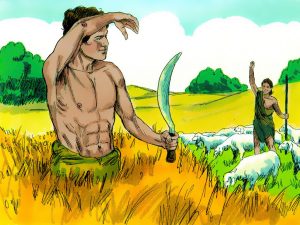 As is typical of most conspiracies, there are differing views on what may have gone down, and the Medrish, many of which we will explore this week, offers at least four of them, let’s see. One theory offered is that Kayin and Hevel struggled over land ownership. Avada we can chap that the world was epes too small for the two of them, and in classic case of dueling brothers, the land grab struggle led to murder. Veyter.
As is typical of most conspiracies, there are differing views on what may have gone down, and the Medrish, many of which we will explore this week, offers at least four of them, let’s see. One theory offered is that Kayin and Hevel struggled over land ownership. Avada we can chap that the world was epes too small for the two of them, and in classic case of dueling brothers, the land grab struggle led to murder. Veyter.
A second opinion maintains that the two brothers were quarreling over who would have the Bais Hamikdash (the Holy Temple) built in their territory. Surely such pious brothers were thinking ahead a few thousand years, and because of their mamish oisergiveyntliche (outstanding) zeal to house no lesser a structure than the Beis Hamikdash, instead a murder was committed. The next two theories are zicher a shtikel more interesting and mistama the Rebbe skipped over these.
A third opinion posits that Kayin and Hevel fought over Chava, each wanting to marry her. Come again! Did we just read that the boys were fighting over the right to marry Chava, Odom’s wife and their own mother? Indeed we did. Nu, calm down you chazerim, and avada we must assume, though avada assuming usually gets one into big trouble, that Odom had divorced his wife Chava, married another with the same name and now the boys, efsher feeling bad for the mama, wanted to marry her, and in the heat of the moment, Kayin did another type of shooting, if you chap. And if you think this medrish is a shtikel out there, let’s look at yet another.
The final opinion cited in the Medrish is that the first Chava had already died, and Kayin and Hevel were arguing over who would marry the extra sister that was born to Hevel. Kayin and Hevel had sisters? Nu, I forgot to tell you that there is another medrish which tells us that each of the boys was born with twin sisters who were seemingly not Toirah-mention worthy.
Back to the Nochosh: having paired Odom and Chava, the RBSO placed them into Gan Eden (Garden of Eden), where they were free to eat anything except the fruit of the Tree of Knowledge. However, Chava fell prey to the nochosh (serpent), who convinced her to eat the forbidden fruit, if you chap; an example many women have followed ever since, if you chap. Good wife that she was, she also shared her fruit with Odom. Ober how could a lowly snake entice Chava so, and how could Chava be so seduced? Did the snake have magical powers?
 Says the heylige Toirah: “The snake was the most cunning of all the beasts of the field that the Lord God had created….” (Bereishis 3:1). And what taka was its sin? Says Rashi (3:14) based upon the heylige Gemora (Sanhedrin 29a), that it is considered an inciter: seemingly, the snake taka did one hec of a job inciting Chava, and, says the Medrish: the snake enticed Chava into having sexual relations. Chava had sexual relations with the snake? Yikes!! Nu, avada we must learn more about this topic, veyter.
Says the heylige Toirah: “The snake was the most cunning of all the beasts of the field that the Lord God had created….” (Bereishis 3:1). And what taka was its sin? Says Rashi (3:14) based upon the heylige Gemora (Sanhedrin 29a), that it is considered an inciter: seemingly, the snake taka did one hec of a job inciting Chava, and, says the Medrish: the snake enticed Chava into having sexual relations. Chava had sexual relations with the snake? Yikes!! Nu, avada we must learn more about this topic, veyter.
Nu, efsher you’re wondering how it’s even shayich (at all possible) for the snake to have sexual relations with Chava? Do snakes do such dastardly things? Is it even possible to fathom that the snake, sneaky as he was, committed adultery with Chava? Even if we imagine the snake as having legs (before his legs were chopped off and God commanded him, “You shall go about on your belly”), the distance between it and humankind remains enormous, and it is quite unclear how it would have enticed Chava into sexual relations. Unless of course the change undergone by the snake after the punishment was so drastic that the snake we know today is in no way similar to its primeval ancestor, and efsher back then it taka had legs, and taka knew how to use them, if you chap, which according to this pshat, he certainly did. Ver veyst.
Unless chas v’sholom (heaven forbid) we assume that Chava was a shtikel bored up in Gan Eden and decided to experiment with different zachin, if you chap, to fight her boredom and that she had some weird perverse sexual orientation, we must efsher kler (think) and accept that the snake had human characteristics, at least externally. It is perhaps for this reason that the snake also knew how to express itself so articulately, and perhaps his intellect was not inferior to that of man. Avada this would also reconcile the fact that the snake was able to conduct real conversation with Chava, and avada using his charm, as snakes typically posses, he was able to entice her into sexual relations. Nu, just about now you must be thinking that the Oisvorfer is mamish an apikoires and worse, ober rest assured that what is being shared is directly from sources which avada include the heylige Gemora, the Medrish, and others.
That all being said, how could the snake taka have such seductive powers over Chava? How could the snake manage to entice Chava, and she Odom, to eat of the forbidden fruit of the Tree of Knowledge? Nu, we must avada conclude that this was no ordinary snake; rather he was of the very cunning variety, smart too. And says the Zoihar and avada who had a better imagination that did he, azoy: the snake was the personification of the Soton (Satan), little devil that he was.
And when did this entire meyseh (incident) take place? Says the Medrish: Chava was created and gave birth on the very same day and that her children were born as adults. As a result however of Chava’s transgression and efsher illicit relationship with the snake, pregnancy was extended to forty weeks, children are born as babies, and avada require much self-sacrifice to raise. Odom didn’t get away scot free either: The RBSO decreed that man will earn his living with difficulty. And says the Medrish: Jewish women were given and are entrusted with three special mitzvois to atone for Chava’s sin: lighting Shabbis candles, separating the Challah (symbolic of the kashrus of the home), and Taharas Hamishpocha (family purity).
Can you imagine that all this took place on Friday, the sixth day? Is it a wonder that the RBSO rested on day seven?
 Hey let’s not forget Odom, Chava’s bashert and husband, and recall that the RBSO himself made this first ever shidduch. Says the Radak: Odom named his wife “Chava” immediately after they committed the sin of partaking of the forbidden fruit. According to the Radak, Odom experienced sexual desire for the first time after partaking of the fruit, and it was thus at this point when he understood that he would cohabit with Chava and beget children with her. He therefore named her “Chava,” which alludes to her being eim kol chai, the “mother of all living beings.”
Hey let’s not forget Odom, Chava’s bashert and husband, and recall that the RBSO himself made this first ever shidduch. Says the Radak: Odom named his wife “Chava” immediately after they committed the sin of partaking of the forbidden fruit. According to the Radak, Odom experienced sexual desire for the first time after partaking of the fruit, and it was thus at this point when he understood that he would cohabit with Chava and beget children with her. He therefore named her “Chava,” which alludes to her being eim kol chai, the “mother of all living beings.”
Ober (however) says the Ibn Ezra and others that Odom and Chava had sexual relations and reproduced while living in Gan Eden. Rashi, in his commentary (4:1), follows this approach and writes that although the births of Kayin and Hevel (Odom and Chava’s two eldest sons) are recorded only after the narrative of the sin, they were in fact born earlier, in Gan Eden. And says Rashi, quoting the Medrish (3:20): the snake saw Odom and Chava engaging in marital relations and desired Chava, prompting it to devise its scheme to have Odom killed. Seemingly the one-eyed snake was already busy scheming.
And what’s the big to do if they did or didn’t have sexual relations or bear children before or after the snake incident? Nu, avada there is a machloikes (disagreement,) and we find different views as to which of Odom’s and Chava’s children were conceived and born in Gan Eden, and which were conceived only later, after the sin of the forbidden fruit.
Says the heylige Gemora (Sanhedrin 38b), that already on the day when Odom and Chava were created, they engaged in marital relations “and four [people] got down [from the bed].” The difficult process of gestation and labor was decreed only later, as punishment for the sin of the forbidden fruit, and thus Odom and Chava’s offspring emerged from the womb immediately after conception. It is unclear, however, who these four people were who got down from the bed. Two of them, of course, were Odom and Chava, but who were the two children? Rav Eliyahu Mizrachi (4:2) explains the Gemora as referring to Kayin and Hevel, and thus in his opinion Kayin and Hevel were twins. Toisfes, by contrast, explained that the Gemora here refers to the famous midrashic tradition of twin sisters born together with Kayin and Hevel. Thus, the two children born in Gan Eden were Kayin and his twin sister; Hevel and his twin sister (or sisters; there are different views as to how many girls were born with Hevel) were born later, after the expulsion from the garden. Another Medrish tells us that from Odom and Chava either four or seven people – meaning, two or five children – emerged from their encounter in Gan Eden. According to one view, Chava delivered quintuplets: Kayin, Hevel, and three sisters. This is the view taken in the Midrash Bereishis Rabba (22:2). The other view, which claimed that only two children emerged, likely held that only Kayin and his twin sister were born in Gan Eden, while Hevel was conceived and born after the expulsion. Lommer chazerin (let’s review.)
1) The Radak and Ibn Ezra held that Odom and Chava did not cohabit until after the sin of the forbidden fruit.
2) According to Toisfes’ understanding of the Gemora’s comment in Sanhedrin, Kayin and his twin sister were born in Gan Eden, while Hevel and his twin sister (or twin sisters) were born after the expulsion.
3) According to Bereishis Rabba, Chava delivered five children in Gan Eden: Kayin, Hevel, and three girls.
Says the heylige Toirah (Bereishis 3,21): “Hashem made for Odom and for his wife garments of skin”. Asks and answers the Yalkut: from where was the skin? From the skin of the serpent whose skin was stripped off. Seemingly the snake stripped down more than once, if you chap. And as expected, many commentaries were not happy to read this pshat. In order to clothe Odom the skin was stripped off the serpent? Surely this is unjust and makes little sense. Not to worry because the Yalkut Reuveni quotes another Medrish which tell us that the garments were made from the skin of the Liviyoson fish (Leviathan), whose skin was removed when it was preserved for the future.
What really happened on that fateful sixth day, ver veyst. Sefer Bereishis is extremely riveting, informative and can be studied for days, weeks and months before one can begin to really chap it. Perhaps that’s the reason we have the custom of learning the heylige Toirah all over beginning this Shabbis, the first after Simchas Toirah.
A gittin Yom Tov –
The Heylige Oisvorfer Ruv
Yitz Grossman
